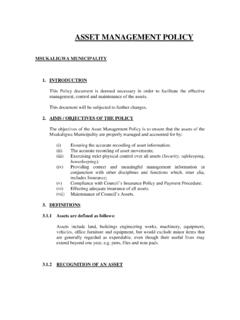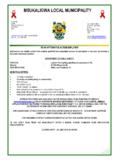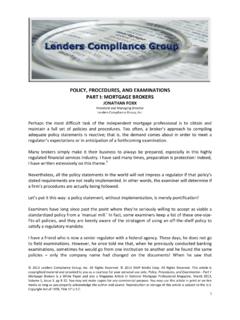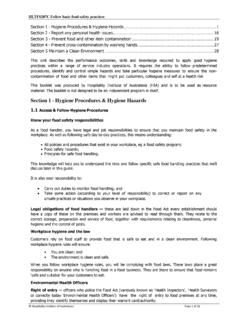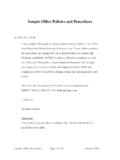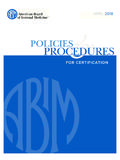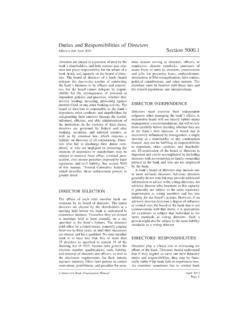Transcription of OCCUPATIONAL HEALTH AND SAFETY POLICY
1 1 MSUKALIGWA MUNICIPALITY OCCUPATIONAL HEALTH AND SAFETY POLICY POLICY Number: LM 900/04/2010 Approved Date: APRIL 2010 Effective Date: 01 MAY 2010 Review Date: Notwithstanding the review date herein, this POLICY shall remain effective until such time approved otherwise by Council and may be reviewed on an earlier date if necessary. Why Have a POLICY ? The Msukaligwa Municipality and its staff believe that the prevention of injuries and exposure to disease of all the employees is of paramount importance to the organisation in its quest to be a leader in HEALTH and SAFETY . Furthermore, management acknowledges its responsibility and moral obligation to provide a safe and healthy workplace. We will strive to be pro active in the recognition of risks with the objective of reducing exposure to injury and disease. Involvement will be at all levels and the responsibility will be shared by everyone, in order to reach the objectives.
2 2 THE POLICY 1. PREAMBLE The need for the POLICY stems from the OCCUPATIONAL HEALTH and SAFETY Act, 1993 which requires employers, including municipalities, amongst other things to develop and adopt an OCCUPATIONAL HEALTH and SAFETY POLICY . Furthermore, this POLICY is intended to create a framework for decision making in respect of human resources management in as far as OCCUPATIONAL HEALTH and SAFETY is concerned in the municipality. To comply with the conditions relating to the OCCUPATIONAL HEALTH and SAFETY Act, Act 85 of 1993 regarding the issue and control of SAFETY equipment/protective clothing as well as to compile a POLICY on the issue and control of other clothing and uniforms which is not legally compulsory The POLICY is intended to: (a) Promote and maintain the highest degree of physical, mental and social wellbeing of workers. (b) Prevent amongst workers, ill HEALTH caused by their working conditions. (c) Place and maintain workers in a working environment that is adapted to their individual physiological and psychological conditions.
3 (d) Protect workers from factors adverse to their HEALTH . (e) Promote and maintain working environment that is free from harassment. 2. DEFINITIONS hazard means a source of or exposure to danger HEALTH and SAFETY committee means a committee established under section 19 of OCCUPATIONAL HEALTH and SAFETY Act, No 85 of 1993, healthy means free from illness or injury attributable to OCCUPATIONAL causes incident means an incident as contemplated in section 24 of OCCUPATIONAL HEALTH and SAFETY Act, Issue means personal SAFETY equipment/protective clothing as well as other clothing and uniforms not compulsory by law. machinery means any article or combination of articles assembled, arranged or connected and which is used or intended to be used for converting any form of energy to performing work, or which is used or intended to be used, whether incidental thereto or not, for developing, receiving, storing, containing, confining, transforming, transmitting, transferring or controlling any form of energy, medical surveillance means a planned programme of periodic examination (which may include clinical examinations, biological monitoring or medical tests)
4 Of employees by an OCCUPATIONAL HEALTH practitioner, or in prescribed cases, by an OCCUPATIONAL medicine practitioner OCCUPATIONAL HEALTH means including OCCUPATIONAL hygiene, OCCUPATIONAL medicine and biological monitoring, 3 OCCUPATIONAL heath practitioner means an OCCUPATIONAL medicine practitioner or a person who holds a qualification in OCCUPATIONAL HEALTH recognised as such by the South African Medical and Dental Council as referred to in the Medical, Dental and Supplementary HEALTH Service Professions Act, 1974 (Act of 1974) or South African Nursing Council as referred to in the Nursing Act, 1978 (Act of 1978), OCCUPATIONAL hygiene means the anticipation, recognition, evaluation and control of conditions arising in or from the workplace, which may cause illness or adverse HEALTH effects to persons, risk means the probability that injury or damage will occur.
5 Safe means free from any hazard. All terminology not defined under clause 2 of this POLICY shall bear the same meaning as in the applicable legislation. 3. LEGAL FRAMEWORK Basic Conditions of Employments Act (Act 75 of 1997) Labour Relations Act (Act 66 of 1995) Municipal Systems Act (Act 32 of 2000) Municipal Finance Management Act (Act 56 of 2003) Locally negotiated agreements (LLF Resolutions) OCCUPATIONAL HEALTH and SAFETY Act (Act 85 of 1993 + Regulations) Compensation for OCCUPATIONAL Injury and Diseases (Act 85 of 1993) Medical, Dental and Supplementary HEALTH Service Professions Act, 1974 (Act of 1974) or South African Nursing Council as referred to in the Nursing Act, 1978 (Act of 1978) 4. SCOPE AND APPLICATION This POLICY applies to all employees of Msukaligwa Municipality. 5. OBJECTIVES OF POLICY To implement an OCCUPATIONAL HEALTH and SAFETY Programme To be aware of all risks and changes in risk factors in areas regarded as high risk To stay abreast of legislative requirements and to meet them as far as is reasonably practicable To train everyone in the municipality on matters pertaining to their work and the associated risks involved To ensure the knowledge and information available is adequate to achieve these objectives To continually evaluate HEALTH and SAFETY programmes, adapting them as and when problems are identified.
6 To partake actively in the accident/incident prevention programme. 4 6. POLICY CONTENT Medical Surveillance Programme A Medical Surveillance Programme is used to identify and record the presence of any OCCUPATIONAL disease and the degree of exposure. The information is used to ensure that the HEALTH of the employee will not be compromised by placement in a particular job. Employees who have a HEALTH condition which will or could be compromised will not be placed in high risk areas. General HEALTH information, not required for the job, is used to identify HEALTH needs and the HEALTH care that the individual would require. Pre-employment examination (PEM) Certain employees will undergo a pre-employment medical examination prior to being appointed to a position. The position being filled will determine whether an examination is needed. The selection criteria will be the risks involved, determined by the job and results kept confidential.
7 The inherent medical requirements will be used to ensure non-discrimination results. A declaration will be signed by the prospective employee to accepting the conditions of the Medical Surveillance Programme and any resulting testing required. The Manager will be notified of the suitability of the prospective employee. Periodic Screenings (PS) Employees working in specific areas or shifts will undergo screening at various intervals, depending on the HEALTH risk profile to risk drivers will be examined annually. A certificate of fitness will be issued. Transfer Screenings (TS) Employees are only screened for the job they are initially placed in. This means that they will not necessarily be suitable to work in another area, except if they are required to be multi-skilled and work in all areas. Thus any employee requiring or applying for transfer would first undergo an assessment to ensure suitability.
8 Legislative Compliance The Council will follow all aspects of the OCCUPATIONAL HEALTH and SAFETY Act no. 85 of 1993 and its Regulations, including any other mentioned documents ( SABS codes). Where specific compliance or risk exists, company rules and procedures will apply. Any training done with respect to the legislation or company HEALTH and SAFETY programme, policies and procedures will be noted and kept on file. Any person who does not adhere to this legislation will be guilty of an offence and thus be disciplined according to the disciplinary code. Injury Reporting In terms of the OCCUPATIONAL HEALTH & SAFETY Act no. 83 of 1993, all injuries and incidents must be reported immediately or as soon as practically possible, for assessment, 5 recording; or possibly investigation. Wearing of Personal Protective Clothing (PPC) and PPE Various occupations will be identified in the job specification as requiring PPC to be worn by the employees.
9 Employees will be required to sign for the PPC, to follow the procedure and undergo training required for correct usage. Where SAFETY clothing or equipment has been issued, it will be seen as an offence if these are not worn at all times, and thus disciplinary action, according to the disciplinary code, will be taken on non-compliance. Refer to PPE POLICY of Msukaligwa Municipality and or the rules hereunder. Hazardous Chemical Substance In Daily Use Material SAFETY Data Sheets will be available regarding the safe use, storage etc, of all chemical substances in use on site. Each department will have the relevant information in an accessible file and ensure the necessary training, according to Section 13 of the OCCUPATIONAL HEALTH & SAFETY Act & Regulations, is given to all. HEALTH and SAFETY Procedures Workplace SAFETY and Protective Clothing Rules Your SAFETY is the constant concern of Msukaligwa Municipality. Every precaution must be taken to provide a safe workplace.
10 OCCUPATIONAL HEALTH and SAFETY Officer makes regular inspections and holds regular SAFETY meetings. He or She also meets with management to plan and implement further improvements in our SAFETY program. Common sense and personal interest in SAFETY are still the greatest guarantees of your SAFETY at work, on the road, and at home. We take your SAFETY seriously and any willful or habitual violation of SAFETY rules will be considered cause for disciplinary actions. Msukaligwa Municipality is sincerely concerned for the HEALTH and well being of each member employee. The cooperation of every employee is necessary to make Msukaligwa Municipality a safe place in which to work. Help yourself and others by reporting unsafe conditions or hazards immediately to your supervisor or to a member of the SAFETY committee. Give earnest consideration to the rules of SAFETY presented to you by poster signs, discussions with your supervisor, posted department rules, and regulations published in the SAFETY booklet.

